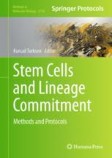Search
Search Results
-
Dissecting the fate of Foxl2-expressing cells in fetal ovary using lineage tracing and single-cell transcriptomics
Gonad somatic cells acquire sex-specific fates during sex determination. In XX gonad, a subset of somatic cells expresses Foxl2 after sex...

-
Single-cell lineage tracing with endogenous markers
Resolving lineage relationships between cells in an organism provides key insights into the fate of individual cells and drives a fundamental...

-

-
Single-cell lineage capture across genomic modalities with CellTag-multi reveals fate-specific gene regulatory changes
Complex gene regulatory mechanisms underlie differentiation and reprogramming. Contemporary single-cell lineage-tracing (scLT) methods use expressed,...

-
Fate-Map** Macrophages: From Ontogeny to Functions
Macrophages are vital to the physiological function of most tissues, but also contribute to disease through a multitude of pathological roles. They...
-
Connecting past and present: single-cell lineage tracing
Central to the core principle of cell theory, depicting cells’ history, state and fate is a fundamental goal in modern biology. By leveraging clonal...

-
Use of a dual genetic system to decipher exocrine cell fate conversions in the adult pancreas
Unraveling cell fate plasticity during tissue homeostasis and repair can reveal actionable insights for stem cell biology and regenerative medicine....

-
Identifying Hmga2 preserving visual function by promoting a shift of Müller glia cell fate in mice with acute retinal injury
BackgroundUnlike in lower vertebrates, Müller glia (MG) in adult mammalian retinas lack the ability to reprogram into neurons after retinal injury or...

-
Lineage Tracing by Single-Cell Transcriptomics Decoding Dynamics of Lineage Commitment
Tracing the fate of individual cells and their progeny is necessary and significant for stem cell research and cancer research. Changes in...
-

-
Lineage tracing shows that cell size asymmetries predict the dorsoventral axis in the sea star embryo
BackgroundCell size asymmetries are often linked to cell fate decisions, due to cell volumes and cell fate determinants being unequally partitioned...

-
CellRank 2: unified fate map** in multiview single-cell data
Single-cell RNA sequencing allows us to model cellular state dynamics and fate decisions using expression similarity or RNA velocity to reconstruct...

-
Lineage Tracing of Spermatogonial Stem Cells Within the Male Germline
Spermatogonial stem cells (SSCs) are the fundamental units from which continuous spermatogenesis arises. Although our knowledge regarding the basic...
-

-
CoSpar identifies early cell fate biases from single-cell transcriptomic and lineage information
A goal of single-cell genome-wide profiling is to reconstruct dynamic transitions during cell differentiation, disease onset and drug response....

-
Single-cell transcriptome analyses reveal critical regulators of spermatogonial stem cell fate transitions
BackgroundSpermatogonial stem cells (SSCs) are the foundation cells for continual spermatogenesis and germline regeneration in mammals. SSC...

-
Sources and Fate of Organic Contaminants in the Marine Environment
The sources, levels, and fate of organic contaminants of major concern in the marine environment are reviewed. Spatial distributions among the...
-
Regulation of developmental gatekee** and cell fate transition by the calpain protease DEK1 in Physcomitrium patens
Calpains are cysteine proteases that control cell fate transitions whose loss of function causes severe, pleiotropic phenotypes in eukaryotes....

-
Gibberellins promote polar auxin transport to regulate stem cell fate decisions in cambium
Vascular cambium contains bifacial stem cells, which produce secondary xylem to one side and secondary phloem to the other. However, how these fate...

-
Epigenetic programming defines haematopoietic stem cell fate restriction
Haematopoietic stem cells (HSCs) are multipotent, but individual HSCs can show restricted lineage output in vivo. Currently, the molecular mechanisms...

